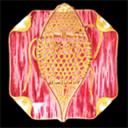 OK, but why Shelly Winters?
OK, but why Shelly Winters?
Presidential Helpmate Barry Landau has taken his cavalcade of dubious presidential history to the Martha Stewart show.
 Landau is out and about promoting his compilation of White House and other menus, The President’s Table, spinning gossamer tales of place settings into THE STUFF OF HISTORY.
Landau is out and about promoting his compilation of White House and other menus, The President’s Table, spinning gossamer tales of place settings into THE STUFF OF HISTORY.
Let Me Show You My Etchings 
He began by telling Stewart a whopper. Landau showed her a papaya-sized belt buckle, which he claims was presented to President Grant by grateful Indian tribes. He described Grant as a great advocate of the Indians, and says “Grant had fought in the Indian Wars.”
That never happened.
When he isn’t making stuff up, Landau’s method is to take an object and buff it up by association with something totally unrelated, or to ascribe vast import to what’s really ephemera.
“When you get these little facts, it’s a rush. I just go floating around. It provides the missing links to presidential history“
He talks up a menu:
“Theodore Roosevelt’s Copper Menu, 1903
Given to Barry Landau as gift from President Roosevelt’s daughter, Alice Roosevelt Longworth, this menu was for a dinner held in Roosevelt’s honor, given by the mayor of Butte, Montana, on May 27, 1903. The dinner followed Roosevelt’s address at the Minnesota State Fair, in which he called for America to assume its responsibilities as one of the great nations of the world.”
Well.
The State Fair speech was a big deal, launching the “walk softly and carry a big stick” catchphrase which has spawned a thousand editorial cartoons. 
And “assuming” our responsibilities has certainly paid off with Cuba, fount of Roosevelt’s glory and subject of much of the speech.
Roosevelt went to Butte on the same tour, didn’t get the ink there.
Landau rushes to share the secrets only he knows, which are pretty much about nothing.
“The one piece Landau describes as the most important in the whole book is a menu on which the wife of the postmaster general wrote the guest list for a secret dinner held by President Ulysses S. Grant as he handed over power to incoming President Rutherford B. Hayes….“Until I found that at a flea market for $10 no one knew who was at that dinner,” Landau says.”
And they would be right not to care.
Landau is looking for the history of great white men and their appetizers, and in this instance especially it is utterly beside the point.
Hayes succeeded Grant in the 1876 election only with spectacular plotting and intrigue. The Democratic winners of the popular vote went along with a dubious Republican Electoral College victory. In return, federal troops abandoned African Americans in the South to their fate. An era of enlightenment did not follow. 
Dups
Along with his dubious history Landau serves up some, shall we say, fanciful numbers.
“I have about 26,000-plus White House menus alone,” said Landau, who keeps most of his collection in a Washington, D.C., storage facility.
As Barry explained, “Menus didn’t really come into use until 1839 or 1840,†which means he’s collected roughly 155 annually for each year since.
 But whether you are piling up those “26,000 menus,” or “24,000 pieces of presidential memorabilia,” or “ about 1 million items,” or “1.2 million pieces,” you’re bound to have a few duplicates.
But whether you are piling up those “26,000 menus,” or “24,000 pieces of presidential memorabilia,” or “ about 1 million items,” or “1.2 million pieces,” you’re bound to have a few duplicates.






